2017 MITSUBISHI OUTLANDER Drive mode
[x] Cancel search: Drive modePage 66 of 521

Supplemental Restraint System (SRS) - airbag
Seat and restraint systems 4-37
4
N00407801532
The SRS includes the following components:
The airbag control unit
monitors the readiness
of the electronic parts of the system whenever the ignition switch or the operation mode is under the following conditions. These include all of the item
s listed above a
nd all related
wiring.[Except for vehicles equipped with the F. A . S . T. - k e y ] The ignition switch is in the “ON” or“START” position. [Vehicles equipped with the F.A.S.T.-key] The operation mode is in ON. The airbags will operate under the same con- ditions as the airbag control unit.
When the impact sensors detect a sufficient front or side impact to deploy the airbag(s),the appropriate airbag
(s) will be deployed.
When the airbag control unit detects rollover of the vehicle, curtain airbags will be deployed. When airbags deploy, some smoke is released accompanied by a loud noise. The smoke is not harmful, but do not
intentionally inhale
the smoke as it may ca
use temporary irrita-
tion to people with respiratory problems. An inflated airbag will
deflate quickly, so you
may not even notice that the airbag wasinflated. Airbag inflation does not prevent the driver from seeing or being able
to steer the vehicle,
and does not prevent people from leaving the vehicle.
N00418601266
This vehicle is equipped with an event data recorder (EDR).
How the Supplemental Restraint System works 1- Airbag module (Driver) 2- SRS warning light 3- Passenger’s airb
ag off indicator
4- Front impact sensors5- Airbag module (Passenger) 7- Driver’s seat position sensor8- Passenger’s seat oc
cupant classifica-
tion sensor system
9- Airbag control unit
10- Side airbag modules11- Curtain airbag modules12- Side impact sensors
CAUTION Airbags inflate very quickly and with great force. In certain situations, contact with aninflating airbag may cause small cuts, abra- sions, and bruises.
Event Data Recording
BK0239700US.book 37 ページ 2016年6月16日 木曜日 午前10時58分
Page 71 of 521
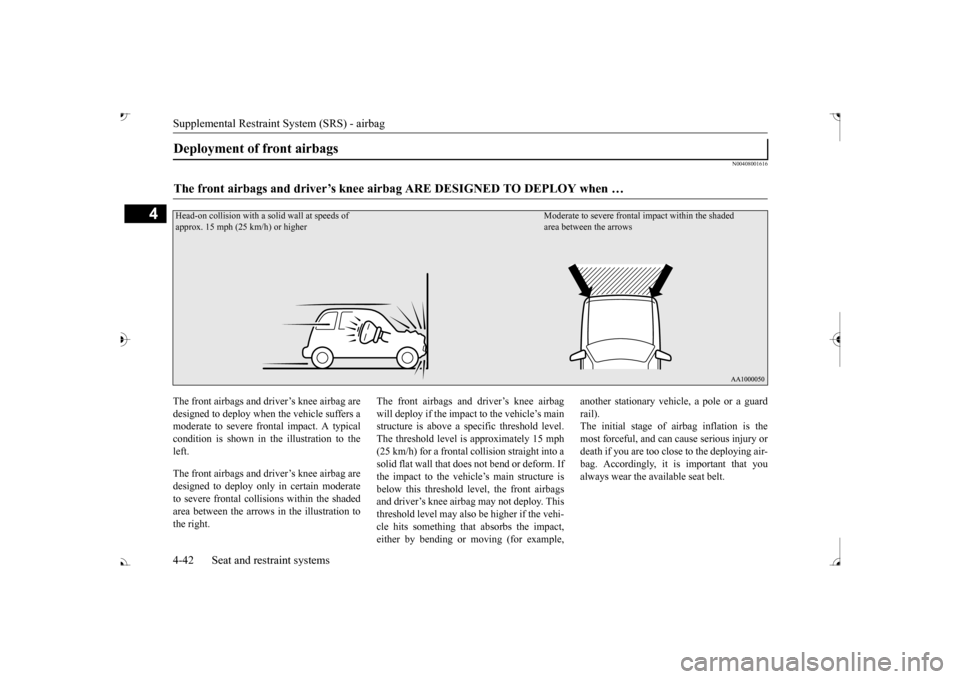
Supplemental Restraint System (SRS) - airbag 4-42 Seat and restraint systems
4
N00408001616
The front airbags and driver’s knee airbag are designed to deploy when the vehicle suffers a moderate to severe fr
ontal impact. A typical
condition is shown in the illustration to the left. The front airbags and driver’s knee airbag are designed to deploy only in certain moderateto severe frontal collisions within the shaded area between the arrows in the illustration to the right.
The front airbags and driver’s knee airbag will deploy if the impact to the vehicle’s main structure is above a sp
ecific threshold level.
The threshold level is approximately 15 mph (25 km/h) for a frontal co
llision straight into a
solid flat wall that does not bend or deform. Ifthe impact to the vehicle’s main structure is below this threshold level, the front airbags and driver’s knee airbag may not deploy. Thisthreshold level may also
be higher if the vehi-
cle hits something that absorbs the impact, either by bending or moving (for example,
another stationary vehi
cle, a pole or a guard
rail). The initial stage of airbag inflation is themost forceful, and can cause serious injury or death if you are too clos
e to the deploying air-
bag. Accordingly, it is important that youalways wear the available seat belt.
Deployment of front airbags The front airbags and driver’s knee airbag ARE DESIGNED TO DEPLOY when … approx. 15 mph (25 km/h) or higher
Moderate to severe frontal
impact within the shaded
area between the arrows
BK0239700US.book 42 ページ 2016年6月16日 木曜日 午前10時58分
Page 73 of 521
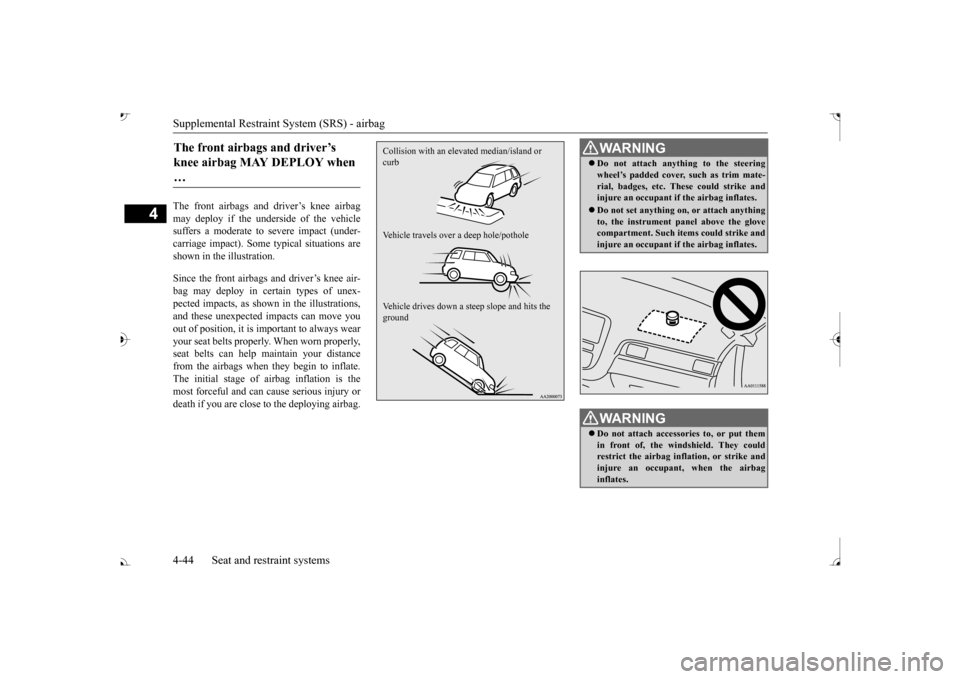
Supplemental Restraint System (SRS) - airbag 4-44 Seat and restraint systems
4
The front airbags and driver’s knee airbag may deploy if the underside of the vehiclesuffers a moderate to
severe impact (under-
carriage impact). Some
typical situations are
shown in the illustration. Since the front airbags and driver’s knee air- bag may deploy in certain types of unex- pected impacts, as show
n in the illustrations,
and these unexpected
impacts can move you
out of position, it is
important to always wear
your seat belts properly.
When worn properly,
seat belts can help maintain your distance from the airbags when they begin to inflate. The initial stage of airbag inflation is themost forceful and can cause serious injury or death if you are close to the deploying airbag.The front airbags and driver’s knee airbag MAY DEPLOY when …
Collision with an elevat
ed median/island or
curb Vehicle travels over a deep hole/pothole Vehicle drives down a steep slope and hits the ground
WA R N I N G Do not attach anything to the steering wheel’s padded cover, such as trim mate-rial, badges, etc. These could strike andinjure an occupant if the airbag inflates. Do not set anything on, or attach anything to, the instrument
panel above the glove
compartment. Such items could strike and injure an occupant if the airbag inflates.WA R N I N G Do not attach accessories to, or put them in front of, the windshield. They could restrict the airbag infl
ation, or strike and
injure an occupant
, when the airbag
inflates.
BK0239700US.book 44 ページ 2016年6月16日 木曜日 午前10時58分
Page 93 of 521
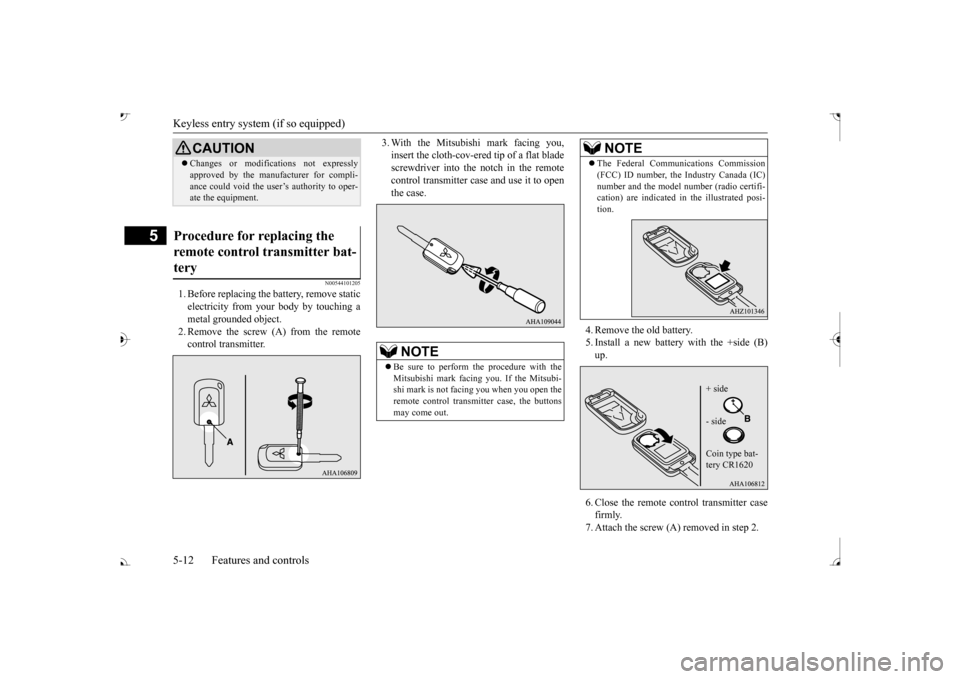
Keyless entry system (if so equipped) 5-12 Features and controls
5
N00544101205
1. Before replacing the
battery, remove static
electricity from your body by touching ametal grounded object. 2. Remove the screw (A) from the remote control transmitter.
3. With the Mitsubishi mark facing you, insert the cloth-cov-ered tip of a flat bladescrewdriver into the notch in the remote control transmitter case and use it to open the case.
4. Remove the old battery. 5. Install a new battery with the +side (B)up. 6. Close the remote control transmitter case firmly. 7. Attach the screw (A) removed in step 2.
CAUTION Changes or modifica
tions not expressly
approved by the manufacturer for compli-ance could void the user’s authority to oper-ate the equipment.
Procedure for replacing the remote control transmitter bat- tery
NOTE
Be sure to perform the procedure with the Mitsubishi mark facing you. If the Mitsubi- shi mark is not facing you when you open the remote control transmitter case, the buttonsmay come out.
The Federal Communications Commission (FCC) ID number, the Industry Canada (IC)number and the model number (radio certifi-cation) are indicated in the illustrated posi- tion.NOTE
+ side - side Coin type bat- tery CR1620
BK0239700US.book 12 ページ 2016年6月16日 木曜日 午前10時58分
Page 94 of 521
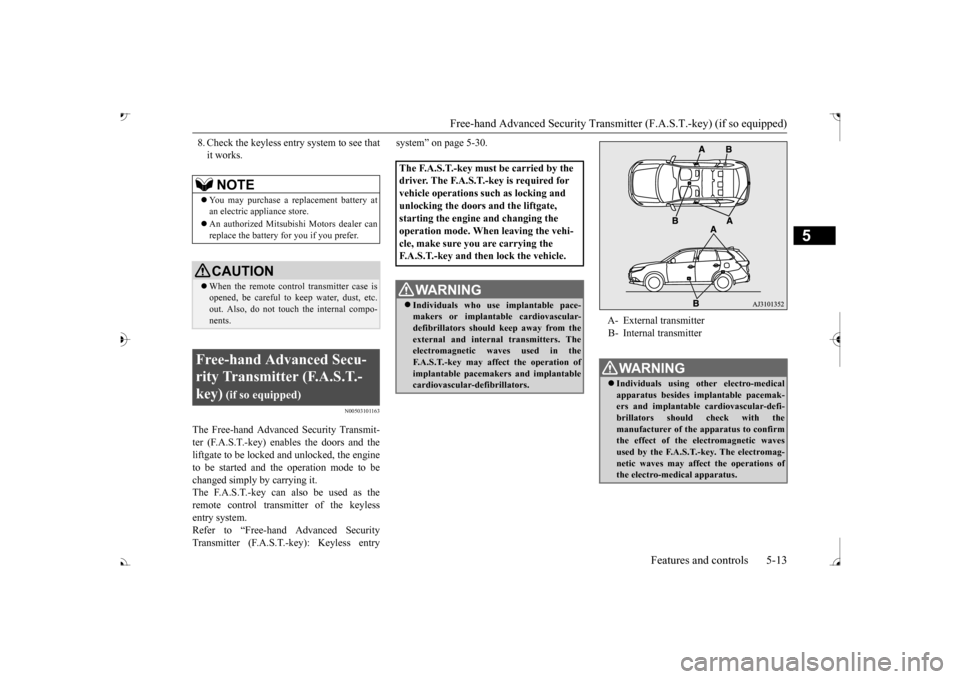
Free-hand Advanced Securi
ty Transmitter (F.A.S.T.-key) (if so equipped)
Features and controls 5-13
5
8. Check the keyless entry system to see that it works.
N00503101163
The Free-hand Advanced Security Transmit-ter (F.A.S.T.-key) enables the doors and theliftgate to be locked
and unlocked, the engine
to be started and the operation mode to be changed simply by carrying it.The F.A.S.T.-key can also be used as the remote control transmitter of the keyless entry system.Refer to “Free-hand
Advanced Security
Transmitter (F.A.S.T.-key): Keyless entry
system” on page 5-30.
NOTE
You may purchase a replacement battery at an electric appliance store. An authorized Mitsubish
i Motors dealer can
replace the battery for you if you prefer.CAUTION When the remote control transmitter case is opened, be careful to keep water, dust, etc. out. Also, do not touch the internal compo-nents.
Free-hand Advanced Secu- rity Transmitter (F.A.S.T.-key)
(if so equipped)
The F.A.S.T.-key must be carried by the driver. The F.A.S.T.-key is required for vehicle operations such as locking and unlocking the doors
and the liftgate,
starting the engine and changing the operation mode. When leaving the vehi- cle, make sure you are carrying the F.A.S.T.-key and then lock the vehicle.
WA R N I N G Individuals who use
implantable pace-
makers or implanta
ble cardiovascular-
defibrillators should keep away from the external and internal
transmitters. The
electromagnetic w
aves used in the
F.A.S.T.-key may affe
ct the operation of
implantable pacemakers and implantablecardiovascular-defibrillators.
A- External transmitter B- Internal transmitterWA R N I N G Individuals using ot
her electro-medical
apparatus besides implantable pacemak- ers and implantable
cardiovascular-defi-
brillators should
check with the
manufacturer of the apparatus to confirm the effect of the el
ectromagnetic waves
used by the F.A.S.T.-key. The electromag-netic waves may affect
the operations of
the electro-medical apparatus.
BK0239700US.book 13 ページ 2016年6月16日 木曜日 午前10時58分
Page 96 of 521
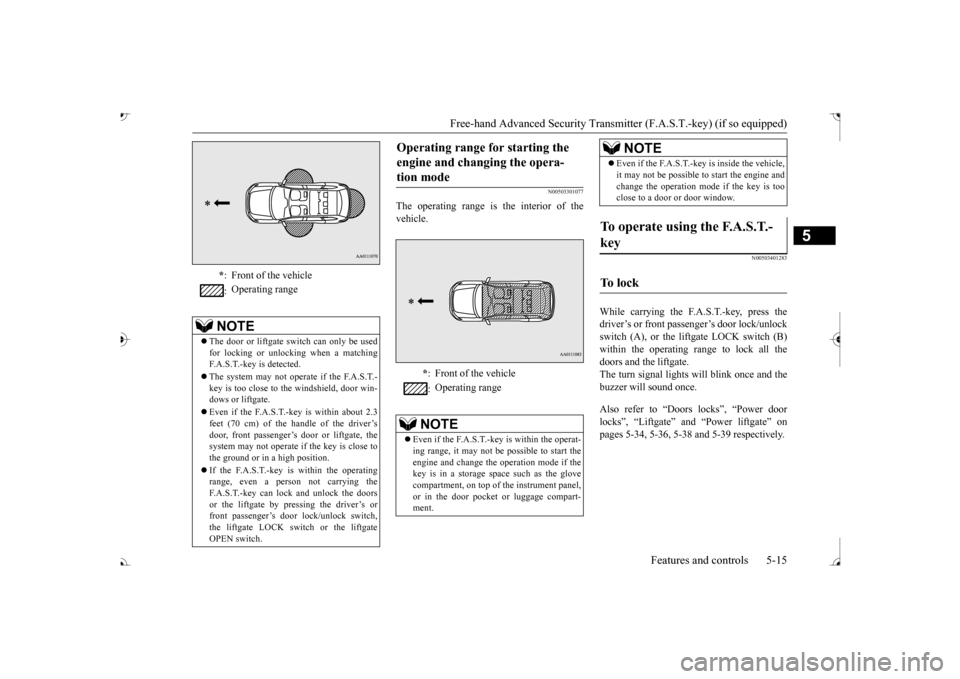
Free-hand Advanced Securi
ty Transmitter (F.A.S.T.-key) (if so equipped)
Features and controls 5-15
5
N00503301077
The operating range is the interior of the vehicle.
N00503401283
While carrying the F.A.S.T.-key, press thedriver’s or front passenger’s door lock/unlock switch (A), or the liftgate LOCK switch (B) within the operating range to lock all thedoors and the liftgate. The turn signal lights will blink once and the buzzer will sound once. Also refer to “Doors locks”, “Power door locks”, “Liftgate” and “Power liftgate” on pages 5-34, 5-36, 5-38 and 5-39 respectively.
* : Front of the vehicle : Operating range
NOTE
The door or liftgate
switch can only be used
for locking or unlocking when a matching F.A.S.T.-key is detected. The system may not operate if the F.A.S.T.- key is too close to th
e windshield, door win-
dows or liftgate. Even if the F.A.S.T.-key is within about 2.3 feet (70 cm) of the handle of the driver’sdoor, front passenger’s door or liftgate, the system may not operate if the key is close to the ground or in a high position. If the F.A.S.T.-key is within the operating range, even a person not carrying theF.A.S.T.-key can lock and unlock the doors or the liftgate by pressing the driver’s or front passenger’s door lock/unlock switch,the liftgate LOCK switch or the liftgate OPEN switch.
Operating range for starting the engine and changing the opera-tion mode
* : Front of the vehicle : Operating range
NOTE
Even if the F.A.S.T.-key is within the operat- ing range, it may not be possible to start theengine and change the
operation mode if the
key is in a storage space such as the glove compartment, on top of the instrument panel,or in the door pocket or luggage compart- ment.
Even if the F.A.S.T.-key is inside the vehicle, it may not be possible to start the engine andchange the operation mode if the key is tooclose to a door or door window.
To operate using the F.A.S.T.- key
To l o c k
NOTE
BK0239700US.book 15 ページ 2016年6月16日 木曜日 午前10時58分
Page 98 of 521
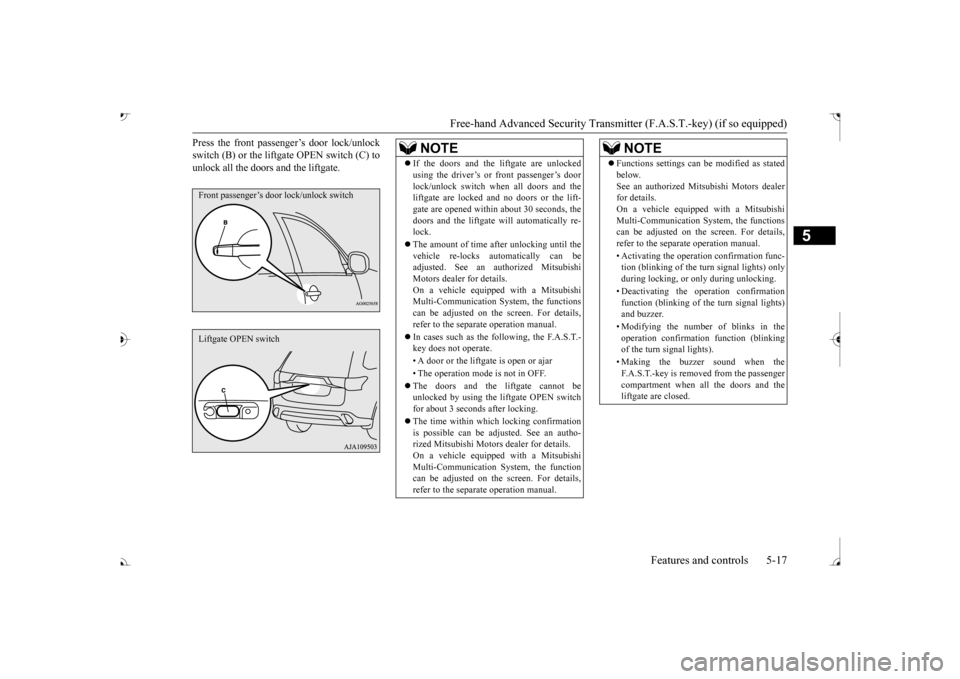
Free-hand Advanced Securi
ty Transmitter (F.A.S.T.-key) (if so equipped)
Features and controls 5-17
5
Press the front passenger’s door lock/unlock switch (B) or the lift
gate OPEN switch (C) to
unlock all the doors and the liftgate.Front passenger’s door lock/unlock switchLiftgate OPEN switch
NOTE
If the doors and the li
ftgate ar
e unlocked
using the driver’s or front passenger’s doorlock/unlock switch when all doors and theliftgate are locked and no doors or the lift- gate are opened within
about 30 seconds, the
doors and the liftgate wi
ll automatically re-
lock. The amount of time af
ter unlocking until the
vehicle re-locks au
tomatically can be
adjusted. See an authorized Mitsubishi Motors dealer for details.On a vehicle equippe
d with a Mitsubishi
Multi-Communication System, the functions can be adjusted on the screen. For details,refer to the separate operation manual. In cases such as the following, the F.A.S.T.- key does not operate. • A door or the liftgate is open or ajar• The operation mode
is not in OFF.
The doors and the liftgate cannot be unlocked by using the li
ftgate OPEN switch
for about 3 seconds after locking. The time within which locking confirmation is possible can be adjusted. See an autho-rized Mitsubishi Motors
dealer for details.
On a vehicle equippe
d with a Mitsubishi
Multi-Communication System, the functioncan be adjusted on the screen. For details, refer to the separate operation manual.
Functions settings can
be modified as stated
below.See an authorized Mitsubishi Motors dealerfor details. On a vehicle equipped with a Mitsubishi Multi-Communication System, the functionscan be adjusted on the screen. For details, refer to the separa
te operation manual.
• Activating the operation confirmation func- tion (blinking of the turn signal lights) only during locking, or only during unlocking. • Deactivating the operation confirmation function (blinking of th
e turn signal lights)
and buzzer. • Modifying the number of blinks in the operation confirmati
on function (blinking
of the turn signal lights). • Making the buzzer sound when the F.A.S.T.-key is removed from the passenger compartment when all the doors and theliftgate are closed.NOTE
BK0239700US.book 17 ページ 2016年6月16日 木曜日 午前10時58分
Page 103 of 521
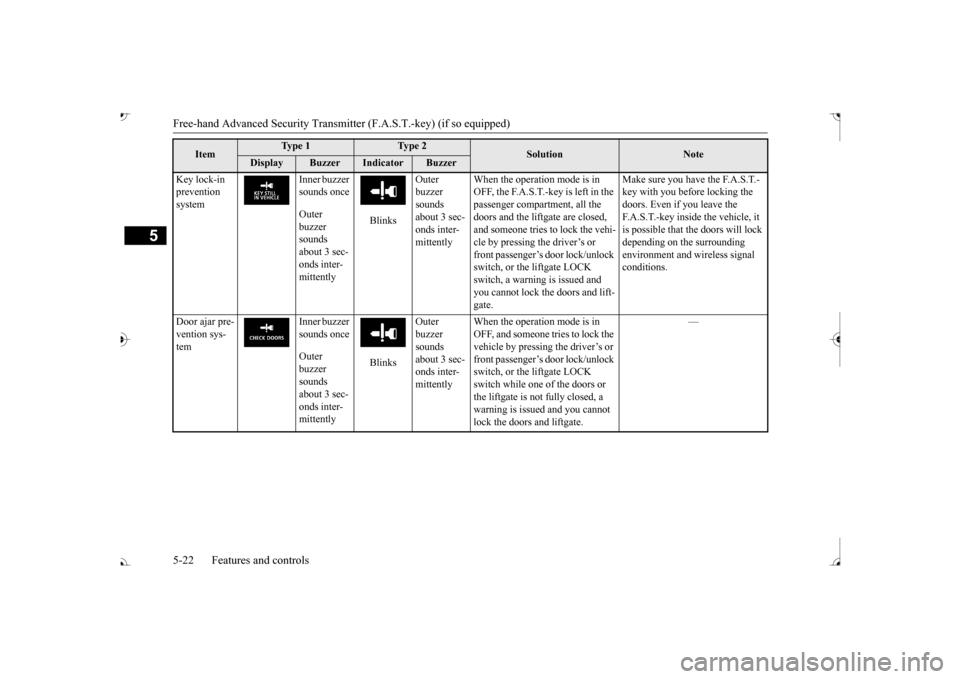
Free-hand Advanced
Security Transmitter (F.A.S
.T.-key) (if so equipped)
5
Key lock-in prevention system
Inner buzzer sounds once Outer buzzer sounds about 3 sec- onds inter- mittently
Blinks
Outer buzzer sounds about 3 sec-onds inter- mittently
When the operation mode is in OFF, the F.A.S.T.-key is left in the passenger compartment, all the doors and the liftgate are closed, and someone tries to lock the vehi- cle by pressing the driver’s or front passenger’s door lock/unlock switch, or the liftgate LOCK switch, a warning is issued and you cannot lock the doors and lift-gate.
Make sure you have the F.A.S.T.- key with you before locking the doors. Even if you leave the F.A.S.T.-key inside the vehicle, it is possible that the doors will lock depending on the surrounding environment and
wireless signal
conditions.
Door ajar pre- vention sys- tem
Inner buzzer sounds once Outer buzzer sounds about 3 sec- onds inter- mittently
Blinks
Outer buzzer sounds about 3 sec-onds inter- mittently
When the operation mode is in OFF, and someone tries to lock the vehicle by pressing the driver’s or front passenger’s door lock/unlock switch, or the liftgate LOCK switch while one of the doors or the liftgate is not fully closed, a warning is issued and you cannot lock the doors and liftgate.
—
Item
Ty p e 1
Ty p e 2
Solution
Note
Display
Buzzer
Indicator
Buzzer
BK0239700US.book 22 ページ 2016年6月16日 木曜日 午前10時58分